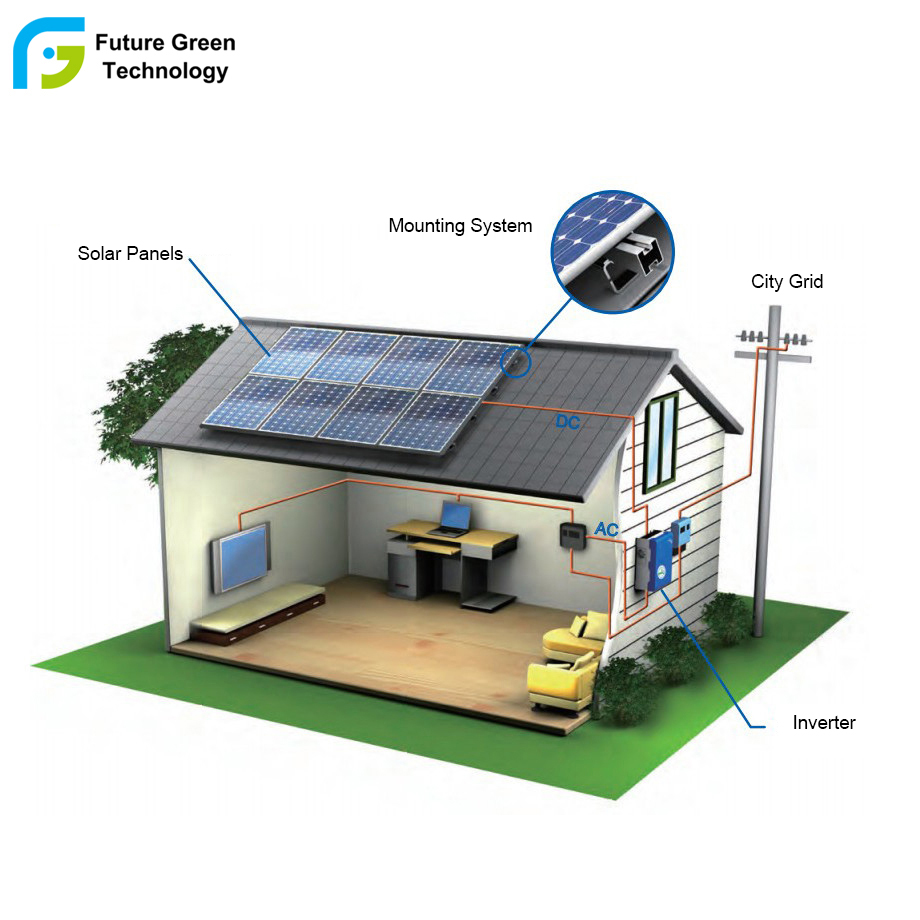In recent years, as the world importance for the photovoltaic industry, solar power systems have been widely utilized in the life. But what should happen to such a high-tech thing? The following Future Green Technology Co., Ltd. summarized the common faults and solutions for photovoltaic power generation systems for everyone, and hopes to help everyone.

First, the inverter LCD is not displayed
Reason analysis:
(1) The battery voltage is not enough. When the battery is just shipped from the factory, it is usually fully charged, but if the battery is not used for a long time, it will be slowly discharged (self-discharge). Off-grid system voltages are 12V, 24V, 48V, 96V, etc. Some applications require multiple batteries in series to meet the system voltage. If the connection cable is not done well, the battery voltage will be insufficient.
(2) The battery terminals are reversed. The battery terminals have positive and negative poles, generally red for the positive pole and black for the negative pole.
(3) The DC switch is not closed or the switch is faulty.
Solution:
(1) If the battery voltage is not enough, the system can't work, the solar energy can't charge the battery, go to another place to charge the battery to more than 30%.
(2) If the problem is the line pressure profile measurements of various electrical battery voltage with a multi-meter. When the voltage is normal, the total voltage is the sum of the voltages of each battery. If there is no voltage, check whether the DC switch, terminal block, cable connector, etc. are normal.
(3) If the battery voltage is normal, the wiring is normal, the switch is also turned on, and the inverter is still not displayed, it may be that the inverter has failed, and the manufacturer should be notified for maintenance.
Second, the battery cannot be charged
Possible reasons:
( 1 ) Component reasons: The component voltage is not enough, the sunlight is low, and the components and DC cable are not well wired.
( 2 ) The battery circuit wiring is not good.
( 3 ) The battery is fully charged and reaches the highest voltage.
Solution:
( 1 ) Check whether the DC switch, terminal block, cable connector, component, battery, etc. are normal. If there are multiple components, separate the tests separately.
( 2 ) When the battery reaches full charge , it can't be recharged, but the voltage is different when different batteries are fully charged. For example, the battery with rated voltage is 12V. When the battery is fully charged, the voltage is between 12.8~13.5V. The specific gravity of the electrolyte when the battery is fully charged. The maximum pressure limit should be adjusted according to the model of the battery.
(3) Input Overcurrent: battery charging current is generally 0.1C-0.2C, the maximum does not exceed 0.3C, and for example, a lead-acid battery section 12V200AH, the charging current is generally between 20A to 40A, the maximum should not exceed 60A. Assembly to the power controller and the power mate.
( 4 ) Input overvoltage: The input voltage of the component is too high, check the voltage of the panel. If it is high, the possible reason is that the number of strings in the panel is too large, and the number of strings in the panel is reduced.
Third, the inverter shows overload or cannot start
Possible reason:
( 1 ) Inverter overload: The inverter overload exceeds the time range, the load power exceeds the maximum value, and the load is adjusted.
( 2 ) Battery overload: The discharge current is generally 0.2C-0.3C , the maximum does not exceed 0.5C , 1 section 12V200AH lead-acid battery, the maximum output power does not exceed 2400W , different manufacturers, different models, the specific values are different .
(3) The load is a load elevator or the like can not be directly connected to the output of the inverter, because the elevator during lowering, reverse the motor will produce a counter electromotive force when entering the inverter, the inverter is damaged. If an off-grid system is necessary, it is recommended to add a frequency converter between the inverter and the elevator motor.
( 4 ) Inductive load starting power is too large.
Solution:
The rated power of the load is lower than the inverter power, and the peak power of the load cannot be greater than 1.5 times the rated power of the inverter.
Battery common problems:
Short circuit phenomenon and cause:
The short circuit of the lead-acid battery refers to the connection of the positive and negative electrodes inside the lead-acid battery. The short circuit phenomenon of lead-acid batteries is mainly manifested in the following aspects:
The open circuit voltage is low and the closed circuit voltage (discharge) quickly reaches the termination voltage. When a large current is discharged, the terminal voltage drops rapidly to zero. When the circuit is open, the electrolyte density is very low, and the electrolyte may freeze in a low temperature environment. When charging, the voltage rises very slowly and remains low (sometimes reduced to zero). When charging, the temperature of the electrolyte rises very quickly. When charging, the electrolyte density rises slowly or almost unchanged. Do not take bubbles or gas when charging.
These are the solar power generation system on common problems and solutions, I hope for your help, you have if there are problems and needs in this area, please contact us Future Green Technology Co., Ltd.

 Monday -Sunday: 8:00 - 24:00
Monday -Sunday: 8:00 - 24:00 No.13 Shang Zhen East RD., Taihe Town Baiyun Area, Guangzhou China
No.13 Shang Zhen East RD., Taihe Town Baiyun Area, Guangzhou China info@futuregreenbattery.com
info@futuregreenbattery.com


